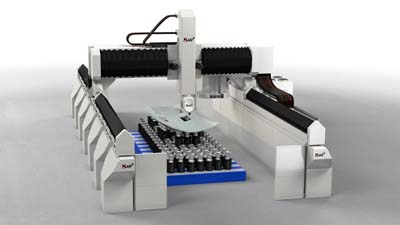Precision Mill/Turn Gantry
Precision Mill/Turn Gantry
Triumph Aerostructures' Vought Commercial Division has ordered two MAG Precision Mill/Trim (PMT) gantry systems for its Hawthorne, CA plant to keep pace with strong market demand. The two high-speed PMT gantries, inaugurating a new high-performance router platform, will be used to produce aluminum wide-body fuselage skins for next-generation commercial aircraft.

Triumph Aerostructures' Vought Commercial Division has ordered two MAG Precision Mill/Trim (PMT) gantry systems for its Hawthorne, CA plant to keep pace with strong market demand. The two high-speed PMT gantries, inaugurating a new high-performance router platform, will be used to produce aluminum wide-body fuselage skins for next-generation commercial aircraft. The two machines will be installed in Q2013 on an existing 140-foot X-axis rail set at Triumph, where two 1995-era Cincinnati (now MAG) gantries are being decommissioned in a phased installation that will allow at least one machine to process parts at all times on the multi-workzone system.
MAG's new modular PMT is a 5-axis gantry machine tool for high-speed multi-processing of large non-ferrous components, such composite structures, aluminum skins and fabrications, molds, patterns, and post-cure cutouts in foam and sandwich structures. In addition to machining, the highly configurable PMT is designed to use various special heads, such as waterjet, sawing and other finishing tools, including a system for precision control of countersink depth.
"The two vintage routers being replaced at Triumph just cannot match this new design, which will set an industry standard for precision large-part machining," said Chip Storie, MAG Executive Vice President. "These new machines will equip Triumph to produce more parts, with improved accuracy, in less time, to keep pace with the company&'s rising production rate for fuselage skins. Modular engineering, utilizing proven component designs, allows us to build these large systems quickly and cost effectively. As the size of parts increases with each new generation of aircraft, there is increasing need for similarly sized automation to finish the details on the parts. We're getting interest in these machines from all corners of the globe, as well as from other markets, such as marine and wind energy."
The PMT's design and capabilities are based on "voice of the customer" requirements for an affordable, multi-purpose platform for fast, accurate large-part finishing processes. The machine's unlimited X-axis is complemented by its configurable Y-axis of 2 to 6 meters; Z-axis of 1, 1.5 or 2 meters; feed rates up to 60 m/min; 5-sided part access; and optional precision scale feedback.
The compact dual-axis rotary spindle head is powered by direct-drive torque motors with encoder feedback, providing 220 degrees of A-axis tilt and standard 550 degrees of C-axis rotation. Options are available for additional or continuous C-axis rotation. The travel ranges provide flexibility to position the cutter to almost any orientation for precision contour machining.
The PMT's rail-type configuration allows a variety of workholding systems to be adapted, including MAG's unique Flexitool universal workholding system. The Flexitool system consists of modular table sections equipped with programmable vertical actuators tipped with swiveling vacuum end effectors that adjust to almost any part shape, so nests of various part shapes can be machined in multiple workzones.
To manage large volumes of chips and reduce maintenance, the machine's X-axis ways have steeply pitched covers that shed chips naturally. The machine's sides are fully enclosed, with large sliding doors on the ends to allow easy access for part loading or inspection. A retractable roof enclosure is available as an option, as is a high-efficiency vacuum system for source-caption of cutting debris.
Five different motorized spindles are available beginning with a standard 22,000 rpm/20 kW and ranging up to 30,000 rpm/42 kW. These high-performance, precision spindles feature an HSK A63 tool interface designed for maximum load and speed. Toolchangers can be located at a position of the customer's choice and include gantry-mounted, disc-type units with 18-24 pockets, or larger capacity chain-type toolchangers in the work zone.
The PMT is available with a Siemens 840sl or Fanuc 31i CNC. Other options to optimize part processing include waterjet cutting head, coolant supply/filtration systems, mist/dust collection systems, video monitoring, probing and others.





